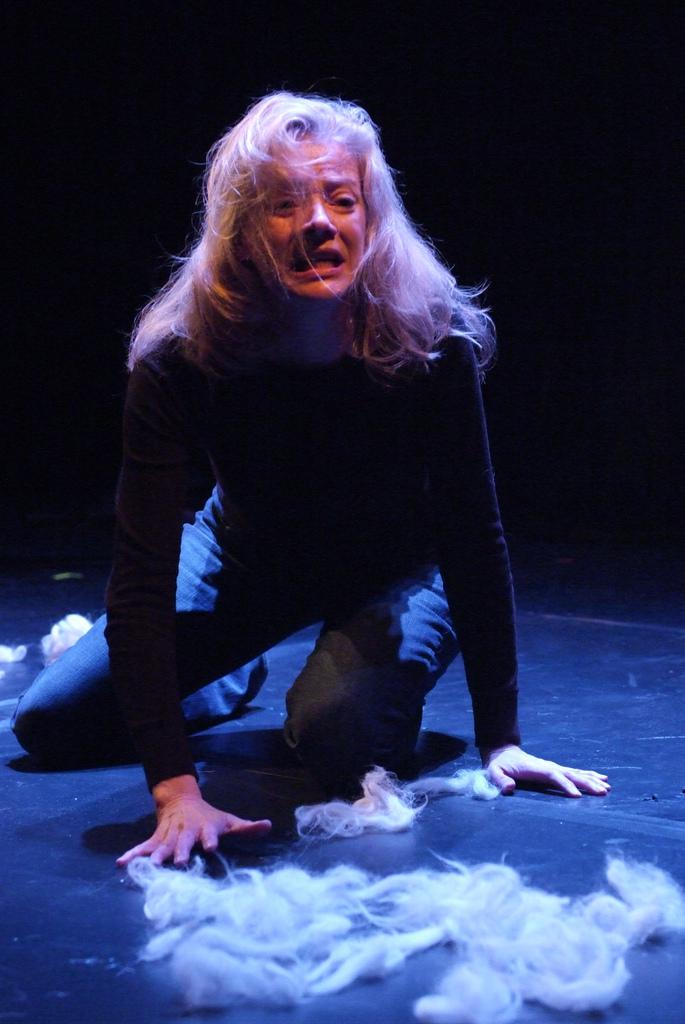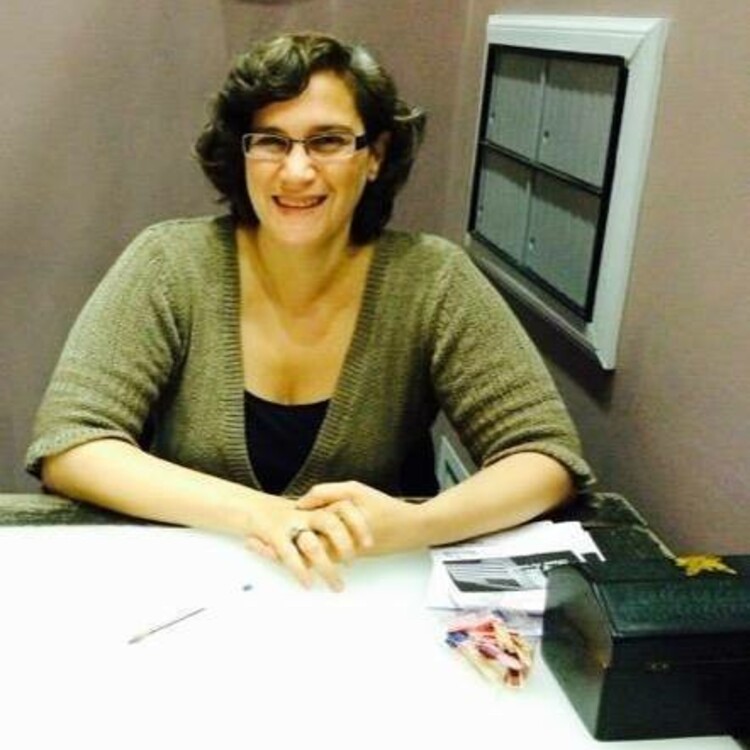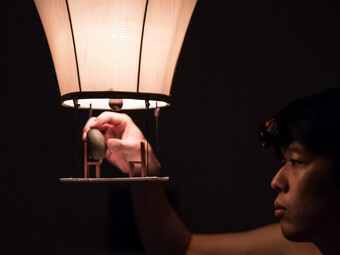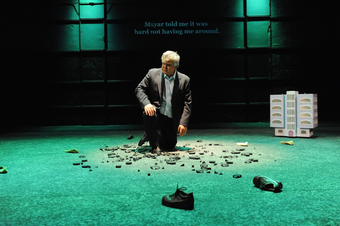Performance Art at the UN Conference on Gender Violence
Groundbreaking performance art can often be a call to action. Dust to Dust, a one-woman show written, directed, and performed by Elizabeth Hess, was presented on the last day of the UN Conference on Gender Violence (December 2-17, 2013.)
Sixteen days of Activism Against Gender-Based Violence was established in 1991 at the first Woman’s Global Leadership Institute. This year’s official theme for the conference was “Orange the World in 16 Days.” The larger conference invited individuals and groups to mobilize and call for the elimination of violence against women and girls. The conference emphasized that gender-based violence is also a violation of human rights.
In Dust to Dust, Hess explored the violence and fears surrounding the systematic rape of women in Bosnia. The war in Bosnia took place between 1992-1995. Bosnia is never mentioned specifically in the play, but that war is indeed source material for the piece. Dust to Dust was originally developed through Voice & Vision, an organization dedicated to supporting women’s theatrical work in New York. It deals with the way in which women’s bodies were used as battlefields. “The play takes place during the course of the war, tracking the terrifying progression from individual rape to gang rape to rape camps,” explained Hess.

Photo courtesy of Elizabeth Hess.
Considering the project from a writer and a director’s point of view, Hess questions how the audience will be able to witness the story, knowing what they bring to it will be dependent on their own experiences and orientation. The story reveals the thoughts and emotions not only of a woman who was raped during war, but also seeks to recognize the circumstances of the soldiers who were involved in such rapes.
Hess’s show is a deeply visceral performance. In different moments of the play, Hess embodies both the woman who is traumatized and the abusive soldier who commits the act. A woman, looking for home, walks across the stage with suitcase. Instinctively looking for a safe place, she continues walking in a circle.

As Hess prepares to move to the next zone, she is demoralized by strip search procedure at a port of call. She is horrified and extends her arms to the side. As she stands there, she remembers the trauma that has passed.
Dust to Dust asks some profound questions. As there is a wish for transcendence, there is also the acknowledgement of the horrors of the war that can drag a person down. After coping with each episode, where can the main character find peace?
Dust to Dust asks some profound questions. As there is a wish for transcendence, there is also the acknowledgement of the horrors of the war that can drag a person down. After coping with each episode, where can the main character find peace? Where can she find safety? Hess feels that in the context of her show, “transcendence refers to the rape victim separating her soul from the suffering of her body. In psychological terms this is known as ‘splitting off’ from traumatic experience.” The character says near the end of the play, “Something flies out of me like a wild colt, bolting before I even know its mine, know its my own soul rearing up, terrified.”

In her performance, Hess portrays both the main character and the solider who rapes her. After the traumatic event, she is dazed and her gaze is vacant. A figure in an act of war, she finds language to describe the larger problems surrounding her.
As Hess repeats movement patterns time and time again, she is worn down. After each act of trauma, we are left to ask, where does the suffering lead? Where is the redemption? What emotions arise from the time and place and how do people endure them?
Though grief stricken, the main character is never completely broken. As part of her cries out, another part of her stands strong before moving to the next moment. As we sense the danger, real and apparent, we understand that there is a longing for something complete and something better.
Hess has worked in traditional and avant-garde theater for years. Her New York credits include work with The New Group, Women’s Project, Irish Rep, MTC and NYTW. She has also worked extensively in regional theaters. Hess’ acclaimed solo work, beginning with the trilogy “Living Openly & Notoriously,” has been performed around the globe: Berlin, Bath, Barcelona, Edinburgh, Toronto and Yerevan, as well as Off-Broadway.
Hess is also writing a book, “The Interplay of Being,” based on her methodology culled from teaching acting at New York University (NYU), The O’Neill Center: National Theater Institute (NTI), Fordham University, and international workshops and master classes.
Transcendent imagery is an important part of Dust to Dust. As her arms are lifted towards the sky it looks as though she is striving for something more powerful in the heavens. Perhaps, she can reclaim the part of herself that was repeatedly dragged down. The images, evoked in word and body, are an essential part of this piece. Hess’ work is descriptive and deeply poetic. As the text of Dust to Dust is often more of a nightmare than a dream, it has moments that read as illusions.
The play includes images of Black Beauty and Pegasus, the winged horse. Taking a fantastical point of view, we see the main character striving towards a better life. That need for completeness is an important struggle after war and devastation. In the otherworldliness, there is a state of grace and wholeness. In portraying the totality of the devastation, Hess makes a statement about people in the aftermath of war.
Dust to Dust was presented during the UN conference and was performed at The Church of the Holy Family (The UN Parish) on 315 East 47th Street. The conference was aimed at individuals, non-governmental organizations, and governmental organizations. It was attended by psychologists, community leaders, and those demanding an end to all forms of violence, particularly gender-based violence.
After the performance of Dust to Dust, Hess, cello player Lucas Syed, and moderator Katrin Kalden led a question and answer session about the piece. During the Q&A, Hess explained that the violence can be so pervasive that there seems like there is no escape. Getting away from the trauma seems almost impossible.
“There is a shaming, but also dealing with home and family after speaking up,” Hess said. She further explained, “I have always felt that this piece needs to be part of a bigger dialogue. It is challenging material and I welcome the opportunity to digest the experience together with the audience afterwards. The piece provides a platform in which to talk about this issue in depth and with real feeling.”
For over half an hour, audience members were able to share ideas that they had about the project and speak about issues of violence and survival. Through guided discussion, attendees were able to voice their concerns and find common ground to discuss this difficult theme.
The National Committee of UN Women sponsors events throughout the year. For more information about their upcoming events, visit http://www.unwomen-usnc.org/.








Comments
The article is just the start of the conversation—we want to know what you think about this subject, too! HowlRound is a space for knowledge-sharing, and we welcome spirited, thoughtful, and on-topic dialogue. Find our full comments policy here